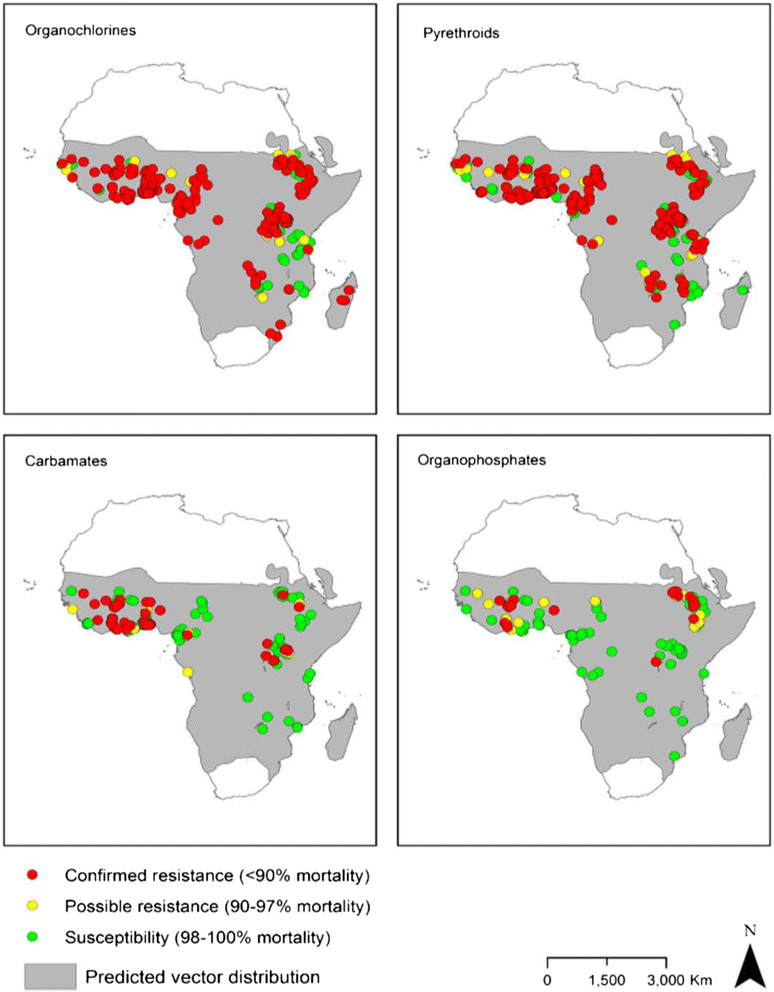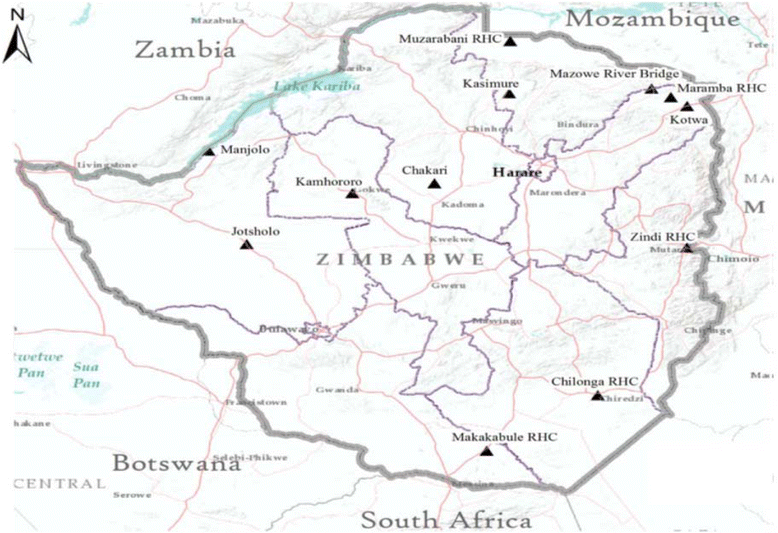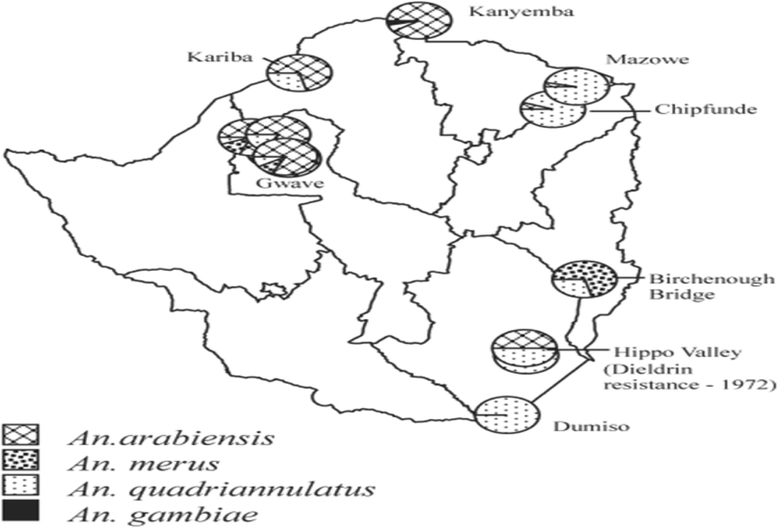Insecticide resistance in malaria-transmitting mosquitoes in Zimbabwe: a review
- PMID: 26497808
- PMCID: PMC4620648
- DOI: 10.1186/s40249-015-0076-7
Insecticide resistance in malaria-transmitting mosquitoes in Zimbabwe: a review
Abstract
Malaria is a global public health problem, with about 3.2 billion people at risk of infection. The populations at risk mainly reside in Africa, Asia and America, with African populations accounting for the largest burden of the disease. In 2013, close to 198 million malaria cases were reported, leading to 584,000 deaths. Much (90 %) of the mortality rates were recorded from the World Health Organization (WHO) database in the African region and 78 % of these occurred in children under the age of five. In Zimbabwe, approximately half of the population is at risk of infection with malaria.Insecticide residual spraying (IRS) has been documented as an effective way to control malaria and has been adopted globally by the WHO and national governments. However, both insecticide resistance and climate change threaten to reverse the progress made by IRS in malaria control. Resistance has been reported in all four classes of insecticides approved by the WHO for vector control intervention. Variability of environmental temperature is suspected to complicate the situation through alteration in the genetic structure, and enzyme and protein profiles of mosquitoes. In Zimbabwe, little research has been done on the interaction between climate change, temperature variability and insecticide resistance in malarial mosquitoes over time. Such information is important for informing policies on insecticide selection for IRS.We reviewed literature on insecticide sensitivity among malarial mosquitoes in Zimbabwe from 1972 to 2014. International peer-reviewed articles on insecticide sensitivity in Zimbabwe, published in English in this time period, were searched using MEDLINE® (PubMed), Google Scholar, Google and grey literature. Eight publications were eligible for the present study, with one of the articles being a review paper. Six articles covered insecticide resistance, while the other two articles, published in 2000, were about the absence of resistance. Contradicting resistance results were reported in 2014.The insecticide sensitivity status and distribution of insecticide resistance in mosquitoes are still under debate in Zimbabwe, as studies report differing results. The resistance trend in Zimbabwe is characterised by fluctuations in the status of the sensitivity of existing insecticides. Inconsistencies in data collection methods may be responsible for the inconsistencies in the results. None of the studies have determined a link between climate/temperature variability and insecticide resistance as yet. The current insecticide sensitivity status of mosquitoes still needs to be verified.
Figures



Similar articles
-
Multi-country assessment of residual bio-efficacy of insecticides used for indoor residual spraying in malaria control on different surface types: results from program monitoring in 17 PMI/USAID-supported IRS countries.Parasit Vectors. 2018 Jan 30;11(1):71. doi: 10.1186/s13071-017-2608-4. Parasit Vectors. 2018. PMID: 29382388 Free PMC article.
-
Folic acid supplementation and malaria susceptibility and severity among people taking antifolate antimalarial drugs in endemic areas.Cochrane Database Syst Rev. 2022 Feb 1;2(2022):CD014217. doi: 10.1002/14651858.CD014217. Cochrane Database Syst Rev. 2022. PMID: 36321557 Free PMC article.
-
Design of a study to determine the impact of insecticide resistance on malaria vector control: a multi-country investigation.Malar J. 2015 Jul 22;14:282. doi: 10.1186/s12936-015-0782-4. Malar J. 2015. PMID: 26194648 Free PMC article. Clinical Trial.
-
[Research progress on malaria vector control].Zhongguo Xue Xi Chong Bing Fang Zhi Za Zhi. 2013 Jun;25(3):312-5, 319. Zhongguo Xue Xi Chong Bing Fang Zhi Za Zhi. 2013. PMID: 24024458 Review. Chinese.
-
Current vector control challenges in the fight against malaria.Acta Trop. 2017 Oct;174:91-96. doi: 10.1016/j.actatropica.2017.06.028. Epub 2017 Jul 3. Acta Trop. 2017. PMID: 28684267 Review.
Cited by
-
Effect of fluralaner on the biology, survival, and reproductive fitness of the neotropical malaria vector Anopheles aquasalis.Malar J. 2023 Nov 7;22(1):337. doi: 10.1186/s12936-023-04767-0. Malar J. 2023. PMID: 37936198 Free PMC article.
-
Insecticide susceptibility status of Anopheles gambiae (s.l.) in and surrounding areas of Lake Tana, northwest Ethiopia.Trop Med Health. 2023 Jan 13;51(1):3. doi: 10.1186/s41182-023-00497-w. Trop Med Health. 2023. PMID: 36639818 Free PMC article.
-
Using search trends to analyze web-based users' behavior profiles connected with COVID-19 in mainland China: infodemiology study based on hot words and Baidu Index.PeerJ. 2022 Nov 9;10:e14343. doi: 10.7717/peerj.14343. eCollection 2022. PeerJ. 2022. PMID: 36389414 Free PMC article.
-
Occurrence of L1014F and L1014S mutations in insecticide resistant Culex quinquefasciatus from filariasis endemic districts of West Bengal, India.PLoS Negl Trop Dis. 2022 Jan 13;16(1):e0010000. doi: 10.1371/journal.pntd.0010000. eCollection 2022 Jan. PLoS Negl Trop Dis. 2022. Retraction in: PLoS Negl Trop Dis. 2023 Jun 20;17(6):e0011417. doi: 10.1371/journal.pntd.0011417. PMID: 35025867 Free PMC article. Retracted.
-
Interfacing vector-borne disease dynamics with climate change: Implications for the attainment of SDGs in Masvingo city, Zimbabwe.Jamba. 2021 Sep 28;13(1):1175. doi: 10.4102/jamba.v13i1.1175. eCollection 2021. Jamba. 2021. PMID: 34691367 Free PMC article.
References
-
- WHO malaria report 2014. WHO,Geneva,2014.
-
- ZNSA. Women and Men in Zimbabwe Report 2012. 2012. http://www.zimstat.co.zw/dmdocuments/Gender/Report2012.pdf. Accessed 22/07/2015.
-
- Midzi S, Teveredzi V, Mudyiradima R, Chihanga S, Netsa M, Mugove A, et al. Zimbabwe Roll Back Consultative Mission (Reaping): Essential actions to support the attainment of the Abuja Targets. Harare: Roll Back Malaria; 2004.
-
- PMI. |Africa IRS (AIRS). Project Indoor Residual Spraying (IRS 2) Task Order Four. In: 2013 Zimbabwe End-of-Spray Report. 2014. Bethesda, MD: PMI|Africa IRS (AIRS) Project Indoor Residual Spraying (IRS 2) Task Order Four, Abt Associates Inc; 2014.
Publication types
MeSH terms
Substances
LinkOut - more resources
Full Text Sources
Other Literature Sources
Medical

